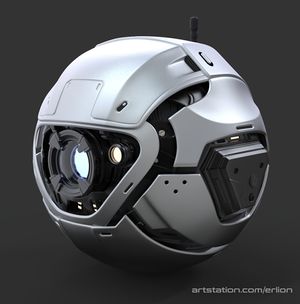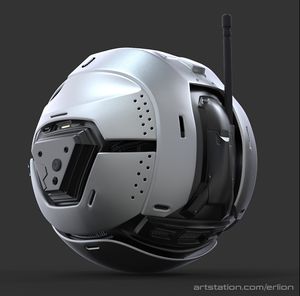There are multiple variants of this technology, please refer to Probe Disambiguation for a list of the variants. |


- Cruising Speed
- 300 kph
- Maximum Speed
- 1000 kph
- Nominal Range
- 1 Meter - 1 AU from Vessel
- Maximum Range
- 21 AU Control
2.5 ly Relay
The newly developed TEUFEL (Tracking and Evasive Unmanned Field Exploration Lookout) Sensor Probe is an entirely new design in remote sensing and threat assessment. These are small 1.7 meter diameter truncated-sphere probes that are launched from a ship. Constructed of energy absorbent materials, they are extremely difficult to detect and operate on a micro-gravity displacement generated within the core by a Spacial Variance Reactor. The probes have a simple AI system that allows them to be given simple commands from their operator.
Their primary purpose is to act as lookouts, flying near the ship to relay sensor information back to the ship's main computer and command center. Equipped with a full sensor suite of short-range and long-range sensors, they can operate independently or in groups. When in groups, they can enhance their sensor strength by arranging themselves into array patterns for higher sensitivity.
TEUFEL Probes can perform sudden direction changes in three-dimensional space within microseconds. They usually follow a pre-programmed erratic path, making them difficult to track. They can also plot random or semi-random course changes for varied sensor readings and enhanced evasion.
A ship can handle 20 TEUFEL Probes operating simultaneously.
Communications
TEUFEL Probes can communicate with the vessel that launched them and with each other. They employ precise point-to-point subspace enhanced direct beam communications, similar to laser pulse communications but operating faster than light. They use subspace high frequency burst communications to communicate with their vessel or with each other, if required.
These probes operate on a multi-dimensional fractal encryption algorithm, routinely altering the timing and frequency range of all subspace communications. This ensures that only the vessel which launched the probes will know the next communication channel, duration, and timing. The encryption keys are also frequently rotated, synced at launch time.
The probes' inter-probe communication protocol, developed independently along a neural net algorithm, adapts to suit each situation. As a result, a set of TEUFEL Probes can only communicate with the ship they were launched from or other probes from that ship. This unique language means that probes from another vessel would be unintelligible, and the next communication channel, frequency, timing, or encryption key would be impossible to predict.
For added security, the signals can be authenticated to a key tied to the ship's transponder code. Although one cannot deduce the key from the transponder code, a fraudulent signal trying to mimic the mother ship would be obvious as the keys would not match, even if the transponder codes did.
Offensive Deployment
While not designed as weapons, TEUFEL Probes can be deployed offensively. They can be directed to overload their power cores, causing sizable explosions. A coordinated detonation of several probes could serve as a powerful last-ditch weapon.